Saturday, November 29, 2003
Billon antoninianus, Mediolanum, Gallienus, Göbl MIR 36, 709b
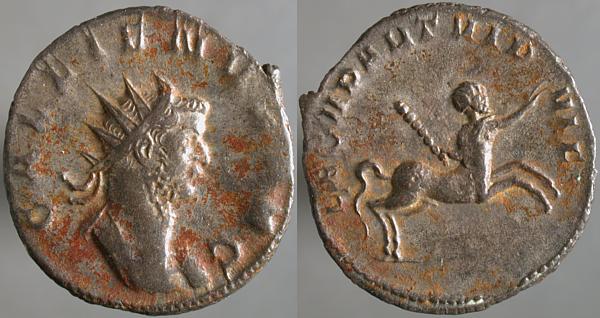
Göbl MIR 36, 709b
GALLIENVS AVG, Radiate cuirassed bust right / LEG II PART VI P VI F, Centaur leaping right, brandishing club.
As mentioned earlier, Gallienus issued coins at Mediolanum honoring his legions, featuring their emblems. This one was issued for Legio II Parthica.
Friday, November 28, 2003
Æ28, Seleuccia ad Calycadnum in Cilicia, Gallienus, Sear GIC 4618
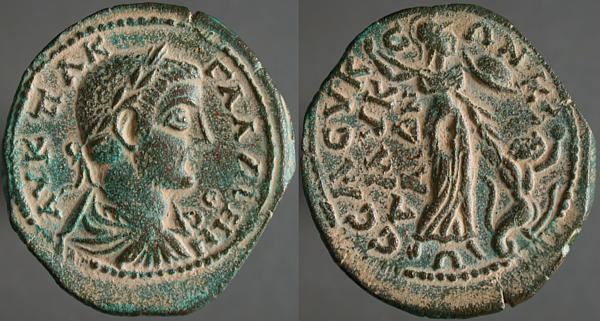
Sear GIC 4618
ΑV Κ Π ΛΚ ΓΑΛΛΙΗΝ / ΟC, Laureate draped cuirassed bust right / CΕΛΕVΚ_Ε_ΩΝ Κ_Α / ΛVΚΑ / ΔΝ / Ω, Athena standing right, holding shield, striking with spear at serpent-legged giant who hurls stone.
Just because I like the way it looks.
Thursday, November 27, 2003
Æ antoninianus, Antioch, Gallienus, Göbl MIR 36, 1613e
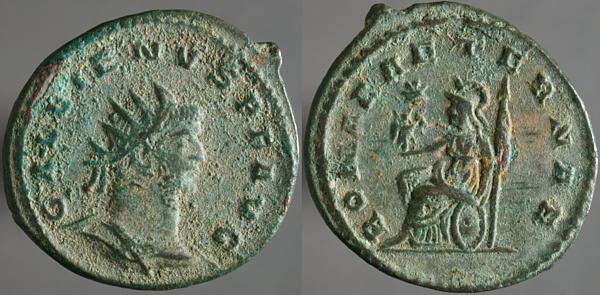
GALLIENVS P F AVG, Radiate cuirassed bust / ROMAE AETERNAE, Roma seated left on shield, holding spear right and Victory left. Star in left field.
The representation of Rome as a helmeted female warrior, seated on a shield, holding a small image of Victory goes back to Republican times, and serves as the model for the Britannia designs on British Æ coinage from the time of Matthew Boulton's 1797 coinage until decimal coinage was adopted in 1971. The US Seated Liberty design is likewise related to this ancient Roman design.
Wednesday, November 26, 2003
Æ19 Seleukid Kingdom, Antiochos VIII & Cleopatra Thea, 122-121 BCE, Sear Greek 7139
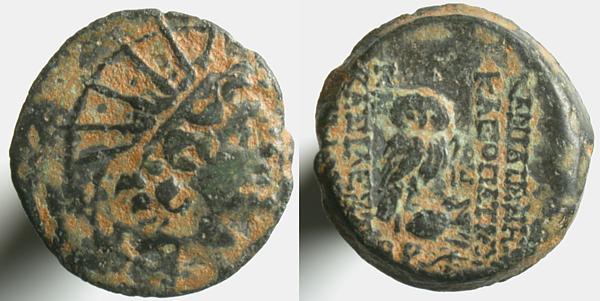
Radiate head right / ΒΑΣΙΛΙΣΣΗΣ ΚΛΕΟΠΑΤΡΑΣ ΚΑΙ ΒΑΣΙΛΕΩΣ ΑΝΤΙΟΧΟΥ, Owl standing right on amphora, head facing. qΡ in exergue.
Alexander the Great died in 323 BCE, aftter which his empire quickly collapsed, his generals and governors establishing their own kingdoms where they were when the news arrived.
Some of these kingdoms lasted for only a short time, others lasted for centuries until they were conquered by the Romans. The Seleukid kingdom was quite long-lived, stably governed until it fell into chaos, with warring claimants to the throne, in 129 BCE and finally coming under Roman control 65 years later.
Tuesday, November 25, 2003
Æ tetradrachm, Alexandria, Gallienus, Emmett 3818(15)

ΑVΤ Κ Π ΛΙΚ ΓΑΛΛΙΗΝΟC CΕΒ, Laureate draped cuirassed bust right / LΙ_Ε, Horus Harpokrates standing facing, head right, palm in left field, Bes in right. Regnal year across fields.
One of the things that make Roman provincial coins different than imperial coins is that explicit political content, except for claims of the importance of the city, is largely absent from the provincials. There were no other claimants to primacy in Roman Egypt, so Alexandrian coins often feature religious subjects.
This coin, minted in the last year of Gallienus's reign, is relatively common, but the reverse type does not seem to have been issued in other years or other reigns.
Monday, November 24, 2003
Silvered Æ antoninianus, Göbl MIR 36, 709b
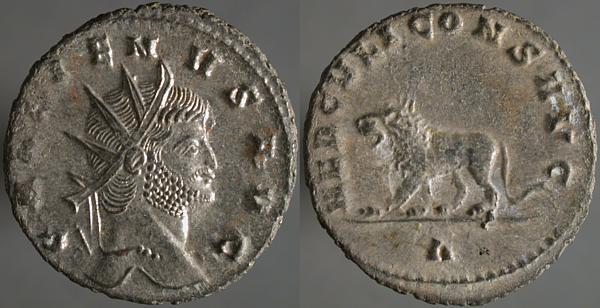
antoninianus GALLIENVS AVG, Radiate head right / HERCVLI CONS AVG, Lion walking left, roaring. A in exergue.
Gloat.
Sunday, November 23, 2003
Æ29, Nicaea in Bithynia, SNG von Aulock 7081
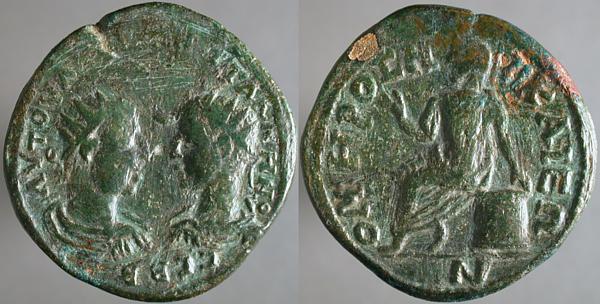
Æ29 ΑVΤ ΟVΑΛ[...]ΓΑΛΛΗΝΟ_C CΕΒ, Confronted radiate draped cuirassed busts of Valerian and Gallienus / ΟΜΗΡΟC Ν_ΙΚΑΙΕΩ_Ν, Homer seated left, with one hand raised.
While many Greek cities claimed to be Homer's birthplace, I know of no connection between him and this city beyond his mention in the Iliad of Antigonia, a city probably on the site of Nicaea. Still, it may be that a local tradition existed, now forgotten.

